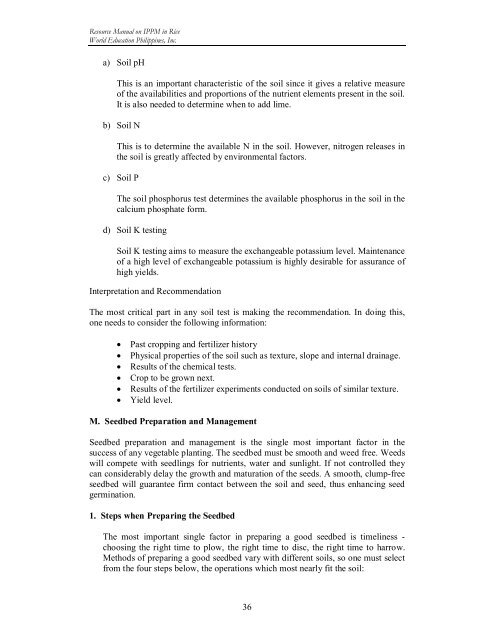(IPPM) in Vegetables - Vegetableipmasia.org
(IPPM) in Vegetables - Vegetableipmasia.org
(IPPM) in Vegetables - Vegetableipmasia.org
You also want an ePaper? Increase the reach of your titles
YUMPU automatically turns print PDFs into web optimized ePapers that Google loves.
Resource Manual on <strong>IPPM</strong> <strong>in</strong> Rice<br />
World Education Philipp<strong>in</strong>es, Inc.<br />
a) Soil pH<br />
This is an important characteristic of the soil s<strong>in</strong>ce it gives a relative measure<br />
of the availabilities and proportions of the nutrient elements present <strong>in</strong> the soil.<br />
It is also needed to determ<strong>in</strong>e when to add lime.<br />
b) Soil N<br />
This is to determ<strong>in</strong>e the available N <strong>in</strong> the soil. However, nitrogen releases <strong>in</strong><br />
the soil is greatly affected by environmental factors.<br />
c) Soil P<br />
The soil phosphorus test determ<strong>in</strong>es the available phosphorus <strong>in</strong> the soil <strong>in</strong> the<br />
calcium phosphate form.<br />
d) Soil K test<strong>in</strong>g<br />
Soil K test<strong>in</strong>g aims to measure the exchangeable potassium level. Ma<strong>in</strong>tenance<br />
of a high level of exchangeable potassium is highly desirable for assurance of<br />
high yields.<br />
Interpretation and Recommendation<br />
The most critical part <strong>in</strong> any soil test is mak<strong>in</strong>g the recommendation. In do<strong>in</strong>g this,<br />
one needs to consider the follow<strong>in</strong>g <strong>in</strong>formation:<br />
· Past cropp<strong>in</strong>g and fertilizer history<br />
· Physical properties of the soil such as texture, slope and <strong>in</strong>ternal dra<strong>in</strong>age.<br />
· Results of the chemical tests.<br />
· Crop to be grown next.<br />
· Results of the fertilizer experiments conducted on soils of similar texture.<br />
· Yield level.<br />
M. Seedbed Preparation and Management<br />
Seedbed preparation and management is the s<strong>in</strong>gle most important factor <strong>in</strong> the<br />
success of any vegetable plant<strong>in</strong>g. The seedbed must be smooth and weed free. Weeds<br />
will compete with seedl<strong>in</strong>gs for nutrients, water and sunlight. If not controlled they<br />
can considerably delay the growth and maturation of the seeds. A smooth, clump-free<br />
seedbed will guarantee firm contact between the soil and seed, thus enhanc<strong>in</strong>g seed<br />
germ<strong>in</strong>ation.<br />
1. Steps when Prepar<strong>in</strong>g the Seedbed<br />
The most important s<strong>in</strong>gle factor <strong>in</strong> prepar<strong>in</strong>g a good seedbed is timel<strong>in</strong>ess -<br />
choos<strong>in</strong>g the right time to plow, the right time to disc, the right time to harrow.<br />
Methods of prepar<strong>in</strong>g a good seedbed vary with different soils, so one must select<br />
from the four steps below, the operations which most nearly fit the soil:<br />
36




![Section 4 [ PDF file, 252 KB] - The Field Alliance](https://img.yumpu.com/51387260/1/158x260/section-4-pdf-file-252-kb-the-field-alliance.jpg?quality=85)












